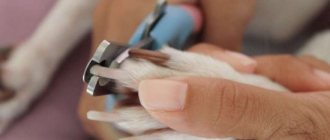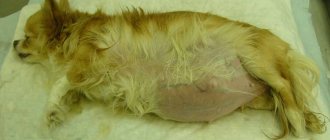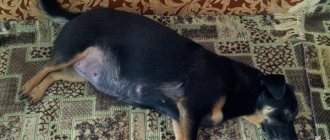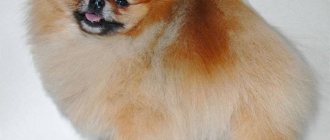8 weeks of pregnancy are behind us, and the final stage of the birth of a new life is approaching - childbirth. Chihuahuas typically give birth easily and without assistance. In most cases, childbirth in Chihuahuas proceeds without complications if the mother meets the following criteria:
- The weight of the woman in labor is at least 1.8-2 kg.
- The optimal age of a female for producing offspring is: 1.5-4 years.
- There are no veterinary contraindications for medical reasons.
Failure of a woman in labor to meet these criteria increases the risk of complications during childbirth and pathological abnormalities in the intrauterine development of puppies during the gestation period.
It is important to periodically monitor the pregnant bitch at the veterinarian. A specialist will competently assess the Chihuahua’s body’s readiness for natural childbirth. If the dog is unable to give birth on its own, a planned cesarean section is performed at a veterinary clinic.
If the veterinarian claims that your pet is able to bathe without surgical intervention from a doctor, then get ready to give birth to your Chihuahua at home. I will tell you further how to properly prepare for the birth of puppies and what is required of you.
Preparing the maternity area
The owner should have worried about preparing the “maternity hospital” 3 weeks before the Chihuahua started giving birth. If this has not been done, then build a maternity box from plywood, or use a spacious, thick cardboard box from household appliances. Subsequently, the box will become a temporary shelter for a dog with small puppies, so carefully consider its architecture.
Place the new “house” for the Chihuahua in a secluded and warm place, for example, close to the radiator. Place oilcloth and a large sheet on the bottom of the box. The dog will build a cozy “nest” from fabric for himself and his newborn babies.
To ensure that a pregnant Chihuahua can easily enter the box, make a proportionate entrance. Make the threshold (side) 10-15 cm high so that the cubs do not voluntarily leave their place of stay in the absence of the mother. For safety reasons, protect the “shelter” of mother and puppies from small children.
If you do not prepare a birthing area for a Chihuahua in advance, the dog will independently choose the place where it will give birth. Such a place may be any hard-to-reach corner of the apartment (house), which will prevent the owner from monitoring the normal course of labor and providing prompt assistance if necessary.
Make sure that the woman in labor spends most of her time in the place prepared for her, sleeping and resting. It is important that after giving birth the Chihuahua stays with the puppies in a designated place, and not anywhere.
Before giving birth to a Chihuahua at home, the owner should take care to ensure that the newborn puppies have an optimal and constant temperature in the apartment (private house). Optimal indoor air temperature for litter: +25-30 ° C. Remember that Chihuahuas are heat-loving dogs and hate sudden changes in temperature, especially cold. Even a small draft can result in the development of a cold in children.
Can a dog give birth on its own?
Only a small proportion of Chihuahua owners place their pets in a clinic for delivery. This is done for medical reasons. When everything is in order with the dog, it is able to give birth on its own without human intervention, but under his supervision.
Giving birth to a dog at home is quite common; it proceeds easily and without outside help if the Chihuahua meets several criteria:
- The woman in labor weighs at least 1.8-2 kg.
- Her age is from 1.5 to 4 years.
- There are no health contraindications.
If a Chihuahua does not meet at least one of the criteria, the likelihood of complications during childbirth and pathological abnormalities in the development of puppies increases.
To ensure everything goes smoothly, a pregnant Chihuahua needs to be seen at a veterinary clinic. The doctor will assess the condition and readiness of the dog to give birth on its own and give the necessary recommendations to the breeder. If a natural birth is not possible, a caesarean section is performed in the clinic.
When Chihuahuas give birth on their own, you need to create an environment of calm and safety at home. The bitch’s labor needs to be monitored from a short distance, and if necessary, be ready to react and help without fuss.
Stocking up on inventory
The tools required for proper childbirth in a Chihuahua are as follows:
- rectal thermometer;
- a heating pad or a couple of plastic bottles;
- hydrogen peroxide or potassium permanganate (potassium permanganate);
- dry and clean cotton towels;
- absorbent diapers;
- sterile sharp scissors;
- surgical forceps or tweezers;
- surgical silk threads or sterile catgut;
- cotton wool and medical alcohol;
- pipettes;
- electronic balance;
- notepad with pen;
- telephone number of the veterinarian or the nearest veterinary clinic in case of emergency.
The list can be supplemented with disposable syringes, Oxytocin or Mastometrin injection solution. The drugs are used to artificially stimulate labor in Chihuahuas. Consult your veterinarian regarding this issue.
Place the tools in a box and store them in a dry and easily accessible place.
Harbingers of approaching birth
The behavior of a Chihuahua changes dramatically before giving birth. The pregnant mother behaves anxiously, frantically looking for a secluded place for “nesting,” digging in rags, scratching the floor, and carefully licking herself. Make sure that this secluded place is a pre-prepared box.
Don’t be surprised if the dog’s character, in the last stages of pregnancy, becomes overly docile and affectionate. The expectant mother is looking for additional affection and psychological support from the owner. Give her a little more attention!
As the birth approaches, the bitch will lose her appetite. Breathing will become heavy, body temperature will drop from the normal level of 38-38.9 ° C to 37-37.5 ° C. The stomach drops low and sags.
It is important to promptly track the beginning of a drop in the dog’s body temperature, therefore, in the last stages of pregnancy, the owner should measure it with a specialized rectal thermometer at least 4 times a day. Has the decline been recorded? Prepare to give birth to a Chihuahua at home approximately 24 hours after the recorded temperature drop! Keep your veterinarian's phone number handy just in case.
Special food
From the fourth week after mating, they begin to increase the daily ration by 2% every 7 days.
If the dog is accustomed to commercial food, then when the gestation period reaches one month, it is transferred to specialized varieties aimed at females bearing offspring. They completely provide the body with the necessary elements.
With a natural menu, increase the amount of kefir, cottage cheese, fruits and vegetables, since the development of fruits requires more calcium, proteins, and various vitamins.
Carrots and buckwheat porridge are also useful for the female. Egg yolk is given weekly. They practice four meals a day. At the same time, make sure that the dog does not overeat.
Expert opinion
Anna Abramenko
An avid dog lover. Experience in veterinary medicine since 2009.
Ask a Question
Approximately 14 days before giving birth, the percentage of foods with a high concentration of calcium and protein in the diet is reduced.
7 days before the expected birth, rice or buckwheat porridge is boiled in water. Add a little butter. They give a mixture of crushed walnuts with grated raisins and dried apricots, and apple pieces. Recommended vegetables include zucchini, pumpkin, and boiled cauliflower. They make balls of rolled oats with cottage cheese.
When drawing up a weekly menu at all stages of pregnancy, you should consult with an experienced veterinarian. He will recommend vitamin and mineral supplements.
The process of giving birth to puppies (whelping)
Just like in humans, the onset of labor in a Chihuahua is accompanied by moderate involuntary contractions of the uterus, simply put, contractions. Duration of contractions: from 6 to 30 hours. During this time, the body prepares for the upcoming birth, the cervix dilates systematically, and subsequently the fetuses are expelled through the birth canal. In general, it is difficult to say how long labor lasts for a Chihuahua, but use this time as a guide. It all depends on the individual characteristics of the bitch’s body and the number of puppies in the litter.
The first 4-6 hours of contraction are practically invisible to the human eye; the time intervals are quite large. Gradually the contractions intensify, the abdominal muscles tense, breathing quickens, vomiting may occur - this is normal! The dog can lick the vulva (loop) and mammary glands. The tail droops, there is trembling in the limbs, and a “wooden” gait. The bitch may be afraid.
Frequent contractions gradually progress into pushing. By this time, the mother had emptied her bowels and bladder in advance and had chosen a position that was comfortable for the birth of the puppies. Chihuahuas often give birth in a standing or lying position, rarely in a sitting position. The owner should not prevent the pet from choosing a comfortable birth position. Clean drinking water should be available in close proximity.
In a Chihuahua, labor begins with the release of the mucus plug and amniotic fluid. As a result of active contraction of the uterus, intrauterine pressure increases. The water bladder with amniotic fluid, transparent gray in color, bursts. The liquid, pouring out, washes the birth canal, which facilitates the subsequent movement along it. There may be a slight presence of blood in the amniotic fluid.
It happens that the bubble does not burst and appears intact from the vagina. In this case, the bitch independently tears it apart with her teeth.
After the amniotic fluid is expelled, the pushing becomes more intense and longer, synchronously alternating with contractions. The first puppy will emerge from the birth canal within approximately 10-30 minutes.
A Chihuahua puppy is born in an airtight membrane with its head or pelvis facing forward, back up. The mother immediately tears the membrane open with her teeth, freeing the baby. She carefully licks the newborn kitten, cleans mucous secretions from the mouth and nose, and gnaws the umbilical cord. An increase in the concentration of carbon dioxide in the blood stimulates the puppy to switch to pulmonary breathing, which is accompanied by squeaking.
Following the puppy, the placenta and remnants of amniotic fluid, separated from the uterus, emerge from the genital tract. Make sure that the number of puppies and placentas match.
Often, immediately after the birth of the first child, a Chihuahua eats the placenta with the fetal membrane and umbilical cord, which is collectively called the afterbirth. Don't interfere! The afterbirth is rich in nutrients and minerals necessary for normal lactation and restoration of strength.
As a rule, the next kitten will emerge within 10-60 minutes, but it is important that the time interval between the birth of puppies does not exceed 2 hours. Without wasting time, wipe your firstborn baby dry with a cotton towel and apply it to your mother's nipple. The baby's sucking actions have a beneficial effect on stimulating the mother's further labor. Place the satiated little one in a box with a hot heating pad, wrapped in wool or cotton cloth. The baby should be warm and soft, but not hot!
Be sure to record in a notebook the time of birth of each puppy, which will become a reporting point until the next baby is born. It is advisable to keep statistics of weight, which is normally approximately 100 grams.
Typically a Chihuahua gives birth to 1-3 puppies. There are cases of multiple litters. The number of babies born must coincide with the veterinarian’s indications made on the basis of an ultrasound image (echography). Otherwise, contact your veterinarian immediately to rule out complications during labor.
The bitch needs to feel safe and calm during labor, and if she is bothered in a bothersome way this can interfere with productive contractions. Closely monitor the actions of the bitch from a short distance, if necessary, be ready to immediately respond and help.
Main features
Four weeks before giving birth, the Chihuahua's belly expands. Within three weeks, the pet’s genitals begin to swell and a clear discharge may appear. Ten days before an important event, the mammary glands enlarge. In some individuals, droplets of milk may appear from the nipples.
When a dog begins to feel contractions approaching, its behavior changes dramatically. The first clear sign of future birth will be the nervous state of the Chihuahua. She begins to rush from side to side, digging the floor with her paws. The pet begins to tremble, breathes quickly, and the heartbeat increases sharply.
Depending on individual characteristics, the dog may look for a corner where there is no light in order to hide from everyone, or vice versa - not leave the owner, constantly caressing him. They also have different attitudes towards food - some pets before giving birth eat as much as you can offer, while others refuse food.
The Chihuahua's anxiety is explained by a sharp increase in the abdominal cavity. This is caused by small but painful contractions. The dog's belly begins to slowly drop down. If this is the pet’s first time, then the lowering of the tummy is not particularly noticeable - there are no characteristic pits on the sides.
Providing assistance to a woman in labor
Usually, human assistance is not required, but if your Chihuahua is giving birth for the first time, the first-time mother may, as a result of stress, not perform direct parental functions during the birth process. Sometimes they even show indifference to their offspring. In this case, the owner’s assistance may include the following:
- Rupture of the membranes.
Within a maximum of 2 minutes after the Chihuahua puppy is born, it is necessary to free it from the fetal membrane, i.e. tear it apart before the baby suffocates. It is more convenient and safer to start from the area under the muzzle. Act quickly, but with extreme caution! - Stimulation of pulmonary respiration.
Clean the newborn's nose and mouth from possible mucus and amniotic fluid residues with a paper napkin. Vigorously, but without strong effort, wipe the baby's chest and back with a warm cotton towel against the grain to stimulate breathing. The little one will squeak, this is normal! - Circumcision and disinfection of the umbilical cord.
At a distance of 2-2.5 cm from the tummy, firmly pinch the umbilical cord with paper tongs or tweezers. The main purpose of the action is to compress the umbilical blood vessels to prevent bleeding after cutting. Using scissors, cut the umbilical cord in the area immediately behind the forceps. Instead of forceps or tweezers, you can use surgical silk threads or catgut to tie the umbilical cord. If the cut site bleeds, gently cauterize the tip of the umbilical cord with a solution of hydrogen peroxide. Treat the peri-umbilical area of the tummy with a weak solution of potassium permanganate, diluted in distilled water until pale pink. Do not pull the baby by the umbilical cord to avoid an umbilical hernia. Use sterile instruments! It is enough to boil them in water for 5-10 minutes, or wipe them thoroughly with medical alcohol. - Directing the puppy towards the mother's nipple.
Usually puppies independently reach the desired mother's nipple, but because... they are born blind, they move blindly. Push the baby in the right direction, or carefully bring it to the nipple, and he will do the rest himself. - Call a veterinarian.
I hope you won’t have to use the service of an emergency veterinarian call to your home, but there are a number of emergency situations when delaying death is like death. More on this below.
Castration and sterilization
Pros and cons
Sterilizing a dog, unlike castration, has many more disadvantages. After such an operation, a false pregnancy may develop, the dog’s character often changes for the worse, and the risk of tumor is high. Castration has fewer disadvantages, although after it the dog gains weight sharply. Problems can be easily avoided if you review your nutrition and exercise plan after surgery.
After castration, dogs become more obedient and flexible, males stop marking their territory, and none of the dogs are attracted to the opposite sex. And the dogs themselves usually become more resistant to diseases and live much longer.
When to castrate?
A male dog needs to be castrated before puberty, at 7-10 months. The bitch is castrated before her first heat, at 4-6 months. If the dog will be neutered after giving birth, you need to wait until the end of lactation.
Pathologies in natural labor
It is important to always be close to the bitch during childbirth in order to promptly identify anomalies in natural labor, and promptly call a veterinary specialist at home to provide professional assistance to the woman in labor. The fact that home births of Chihuahua puppies are accompanied by complications is indicated by characteristic signs:
- Pregnancy lasts more than 70 days; Chihuahuas do not give birth.
- 24 hours have passed since the body temperature dropped below 37.5 °C, and there are no signs of the onset of labor.
- Expel purulent or bloody vaginal discharge suggesting hemorrhage or uterine rupture. Possible cause: cervical dystocia.
- Expulsion of dark green fluid before the birth of the first puppy indicates premature separation of the placenta. Expulsion of the placenta during normal childbirth occurs after birth!
- The subsequent fetus has not been expelled from the birth canal for more than 60 minutes, although the woman in labor exhibits persistent efforts as a result of active contractions.
- The bitch experiences terrible and convulsive pain during the birth process, whines, looks exhausted, and is in shock.
- Weak labor, uterine contractions are weak or absent. A subcutaneous injection of the drug Oxytocin is required to stimulate contraction of the uterine muscles.
- Not all puppies were born, but the bitch did not begin giving birth to the next baby for more than 2 hours, and no contractions were observed.
- The number of placentas with all membranes does not coincide with the number of newborns, and labor activity to expel the placenta from the uterus and birth canals has ceased.
In some cases, the veterinarian will resort to delivery by caesarean section. If a Chihuahua fails to give birth naturally, then surgical intervention by a specialist does not require delay.
Caring for a Chihuahua after giving birth
Congratulations, you have become a “dad”, the happy owner of a litter of Chihuahua puppies! However, it is too early to rejoice; the mother and her offspring require careful care and close monitoring of their health.
When the birth of Chihuahua puppies is successfully completed, it is necessary to wipe the dog’s genitals, belly and nipples with a clean cloth soaked in a weak solution of potassium permanganate. Then put the family’s place in order. Get rid of “traces” of labor and replace the soiled litter. In a word, clean up the place of birth!
As I already said, a dog can eat the afterbirth in the intervals between births, or after they are completed. After this, do not feed the animal for 4-5 hours. If she hasn’t done this, then invite her to try an egg omelet or low-fat cottage cheese. In general, during lactation it is important to feed the bitch properly, but on this issue it is wiser to consult a veterinarian. Drinking water must remain available at all times.
Let mommy rest and be alone with the little ones for a few hours. She needs to get herself and the kids in proper shape.
After 3-4 hours, you can take the bitch for a walk in the fresh air. Walking promotes accelerated postpartum recovery of the bitch’s body, the return of the uterus to normal, and stimulation of high-quality milk production. Do not force the animal to walk for a long time. For the first week, it is enough to spend 30-60 minutes outside every day. If you feel that the dog is tired, then pick it up and go home. Gradually increase the duration of walks to the previous regime.
When leaving, it doesn’t hurt to ventilate the room, but make sure there is no draft and the likelihood of a significant drop in temperature during your absence. Meanwhile, the puppies will sleep in their den. Remember that the sides of the box must be high enough to prevent the little ones from leaving their place of deployment without permission?
How does pregnancy usually proceed in Chihuahuas?
Chihuahuas reach puberty with their first heat (at 6-8 months), but a responsible breeder will not breed a dog during this period. She is not ready for pregnancy and childbirth, either physically or psychologically. The first mating is recommended at the age of one and a half years, when the girl’s weight exceeds one and a half to two kilograms. Due to the small size of sneezes, childbirth at too young an age can end tragically for both the pet and her offspring. The maximum mating period is 10 years.
It is quite difficult to understand that a dog is pregnant in the first three weeks after fertilization. A blood test, ultrasound or x-ray can only confirm pregnancy in the third week. If the owner carefully observes the dog, he may notice a number of changes that occur 12-14 days after mating:
- An active Chihuahua becomes calm, and a phlegmatic one becomes fussy.
- She sleeps a lot.
- Appetite decreases.
- Vomiting is possible due to toxicosis.
- The mammary glands and nipples swell.
In the fifth week of pregnancy, the expectant mother’s activity decreases even more; she behaves calmly during walks, asks to go home and spends a lot of time on the bed. Gradually, the Chihuahua's belly increases in size. After the fourth week, toxicosis stops and appetite improves. After seven weeks, you may notice mucous discharge from the loop and colostrum in the breast. Immediately before giving birth (a day before), the Chihuahua's behavior is restless, she often licks herself, and her breathing becomes intermittent.
Possible postpartum complications
During the first 2 weeks after giving birth, carefully monitor the health of your Chihuahua bitch for postpartum complications. Continue to measure your Chihuahua's body temperature at least once a day for 2 weeks.
After birth, the Chihuahua’s body temperature gradually stabilizes to normal values – 38-39.9°C. However, for the first 2-3 days, temperature readings may be slightly high, fluctuating between 39-39.5°C, especially if the dog has a lot of milk. Exceeding the temperature above 40°C, or prolonged persistence of elevated values for more than 3 days, is a cause for concern.
The greatest danger to the health and life of a nursing Chihuahua bitch in the postpartum period is:
- Pyometra
(inflammation of the uterus). Symptoms: fever, foul-smelling vaginal discharge, decreased milk production, indifference to puppies, lethargy and loss of appetite, elevated body temperature. A terrible disease that, without proper treatment, will lead to septic infection and subsequent death. - Eclampsia
(milk fever). Symptoms: nervousness, restlessness and excitement, loss of interest in cubs, clumsy and difficult gait. If treatment for eclampsia is delayed, the disease will progress. Muscle spasms, unsteadiness, disorientation, fever, convulsions and death will develop. - Mastitis
(inflammation of the mammary glands). Accompanied by enlargement of the mammary glands, increased body temperature, redness of the affected lobes, compaction and swelling of tissues. Touching the affected lobe of the mammary gland causes pain, twitching and whining in the dog. There may be purulent or bloody discharge from the nipple mixed with colostrum (milk). Feeding puppies from the affected lobes of the mammary gland is undesirable, so make sure that they feed from the nipples of healthy mammary lobes. In some cases, you will have to give up breastfeeding altogether and switch to artificial formula. Don't delay treatment!
A healthy mother is vigilant and attentive to her newborn babies. He spends all his time with them, leaving only when absolutely necessary, for example, to go to the toilet, eat or go for a walk. After which she immediately returns to the puppies, licks, cares for and breastfeeds them. Lack of interest in the offspring may indicate poor health of the mother and the development of postpartum complications.
If you suspect that the problems described above are present in your dog, then do not delay a visit to the veterinary clinic.
First vaccination schedule for dogs
From the age of 2 months, pets begin to be vaccinated against major diseases. To do this, contact a veterinarian who will help you draw up a vaccination schedule.
All main vaccines are combined, that is, puppies are vaccinated against several diseases at one time.
7-10 days before each vaccination, the dog is wormed.
For this, anthelmintic drugs with o. For example, Drontal. The dosage and rules of use are according to the instructions.
Before vaccination, a veterinarian examination is required.
Approximate vaccination calendar
| Name of the disease | First vaccination age in weeks | Second vaccination age in weeks | Revaccination age in weeks |
| Plague | 8-10 | 21-28 | 1 year |
| Infectious hepatitis | 8-10 | 21-28 | 1 year |
| Parvovirus enteritis | 8-10 | 21-28 | 1 year |
| Parainfluenza | 8-10 | 21-28 | 1 year |
| Leptospirosis | 8-10 | 21-28 | 1 year |
| Rabies | 12-13 | — | 1 year |
| Trichophytosis | 4-24 | 10-14 | 1 year |
| Microsporia | 4-24 | 10-14 | 1 year |
Subsequently, the dog is vaccinated every year.
After vaccination, the animal is lethargic for 1-2 days.
One-time vomiting or diarrhea, one-time refusal to eat are allowed. A pea-sized lump appears at the injection site, which resolves within 2 weeks to 2 months.
Complications after vaccination develop extremely rarely.
More often when vaccinating a sick animal, using an expired or improperly stored vaccine.
Be sure to get your pets vaccinated
Signs:
- increased body temperature more than 39 °C;
- repeated vomiting and diarrhea;
- increased lethargy and weakness;
- profuse drooling;
- labored breathing;
- complete refusal to eat.
In all these cases, call the veterinarian immediately; you cannot do anything on your own.











